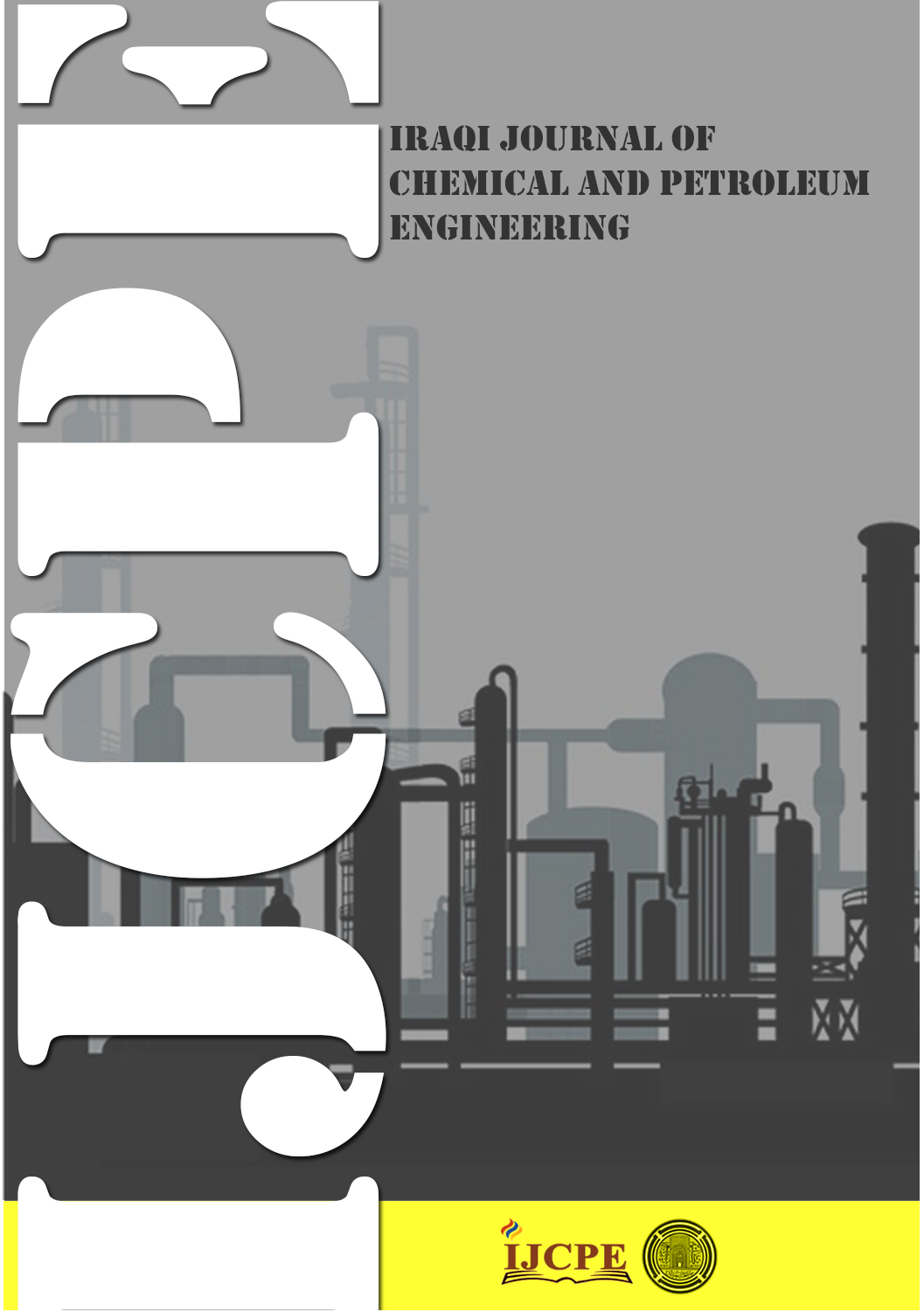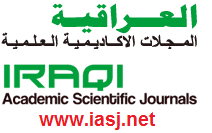Enhanced oil recovery (EOR) by ionic liquid assisted with low salinity water: Experimental study in carbonate rock
DOI:
https://doi.org/10.31699/IJCPE.2025.2.13Keywords:
Wettability alteration; Enhanced oil recovery (EOR); Low salinity water (LSW); Dodecyl pyridinium chloride; Ionic liquidAbstract
There is a growing imperative to extract oil not only through primary and secondary means but also via tertiary recovery methods to meet the escalating global energy demands. Consequently, Enhanced Oil Recovery (EOR) is slated to increase significance in the oil industry in the coming years. The amalgamation of low salinity water (LSW) with chemicals to augment oil recovery has gained substantial traction in recent years owing to its demonstrated effectiveness. In this study, a systematic investigation utilizing contact angle measurements to elucidate the underlying mechanisms was undertaken. The results reveal that the contact angle (CA) demonstrated the effectiveness of the combined fluid in altering the wettability from oil-wet to water-wet. The stability of the ionic liquid C12PYCL under reservoir conditions was indicated by thermogravimetric analysis (TGA) and UV-visible spectroscopy. Following the injection of LSW for secondary recovery, core flooding tests were conducted for two different concentrations of the ionic liquid. This resulted in additional oil recoveries of 17% and 19.7% OOIP respectively, at a flow rate of 0.667 cm3/min. At the higher concentration of the ionic liquid, core flooding tests were conducted across a range of flow rates (0.334, 1, and 1.375) cm3/min, resulting in additional recoveries of 5%, 10.5%, and 8.2% OOIP. This study stands as one of the pioneering investigations in the southern oil fields of Iraq, exploring the potential of enhanced oil recovery across varying flow rates using a hybrid solution comprising LSW and ionic liquid.
Received on 09/07/2024
Received in Revised Form on 02/02/2025
Accepted on 02/02/2025
Published on 30/06/2025
References
[1] X. Deng, Z. Tariq, M. Murtaza, Sh Patil. M. Mahmoud, and M. Shahzad, “Relative contribution of wettability Alteration and interfacial tension reduction in EOR: A critical review”, Molecular Liquids, vol. 325, pp.115175, 2021. https://doi.org/10.1016/j.molliq.2020.115175
[2] N. R. Morrow, G. V. Tang and M. X. Xie, “Prospects of improved oil recovery related to wettability and brine composition”, Petroleum Science and Engineering, vol. 20, no. 3, pp. 267–276, 1998. https://doi.org/10.1016/S0920-4105(98)00030-8
[3] G. Tang and N. R. Morrow, “Influence of brine composition and fines migration on crude oil/brine/rock interactions and oil recovery”, Petroleum Science and Engineering, vol. 24, pp. 99–111, 1999. https://doi.org/10.1016/S0920-4105(99)00034-0
[4] E. Alagic, K. Spildo, A. Skauge, J. Solbakken, “Effect of crude oil ageing on low salinity and low salinity surfactant flooding”, Journal of Petroleum Science and Engineering, vol. 78, pp.220–2227, 2011. http://dx.doi.org/10.1016/j.petrol.2011.06.021
[5] R. Jalil, H. Hussein, “Alteration wettability of carbonate rocks by Nano fluids and comparison with PEG and SDS, Journal of Petroleum Research & Studies, vol. 29, no. 12, 2020. http://dx.doi.org/10.52716/jprs.v10i4.367
[6] G. N. Jreou, “Increasing of Oil Field Productivity by Implementation of Re-entry Horizontal Injection Well, Case study”, Iraqi Journal of Chemical and Petroleum Engineering, vol. 13, no. 3, pp. 17–34, 2012, https://doi.org/10.31699/IJCPE.2012.3.3
[7] M. H. Derkani , A. J. Fletcher, W . Abdallah, B. Sauerer, J. Anderson and Z. J. Zhang, “Low Salinity Waterflooding in Carbonate Reservoirs: Review of Interfacial Mechanisms”, Colloids Interfaces, vol20, no. 2, 2018. http://dx.doi.org/10.3390/colloids2020020
[8] H. A. Baker, K. A. Alwan and S. F. Fadhil, “Enhanced Oil Recovery using Smart Water Injection”, Journal of Engineering, vol. 24, no. 8, 2018. https://doi.org/10.31026/j.eng.2018.08.04
[9] A. H. Assi, F. H. M. Almahdawi, and Q. A. Khalti, “The Influence of Glass Fiber and Milled Glass Fiber on the Performance of Iraqi Oil Well Cement”, Journal of Petroleum Research and Studies, vol. 11, no. 2, pp. 30-48, 2021. https://doi.org/10.52716/jprs.v11i2.496
[10] M. Mahdi, S. Al-Anssari, and Z.-U.-A. Arain, “Influence of Nanofluid Flooding on Oil Displacement in Porous Media”, Iraqi Journal of Chemical and Petroleum Engineering, vol. 24, no. 2, pp. 19–30, 2023, https://doi.org/10.31699/IJCPE.2023.2.3
[11] B. Haq, “Green Enhanced Oil Recovery for Carbonate Reservoirs”, Polymers, vol. 13, pp. 3269, 2021. https://doi.org/10.3390/polym13193269
[12] M. Kh. Jalil, “Q. Hussein and R. R. Jalil, “Study of the effect of ionic liquid on the wettability alteration of carbonate reservoir”, Chemical Papers. Volume 77, pp. 3663–3669, 2023, https://doi.org/10.1007/s11696-023-02728-0
[13] A. Kokorin, Ionic Liquids: Applications and Perspectives. Intechopen, 2011. https://doi.org/10.5772/13974
[14] M. Earle, and K. Seddon, “Ionic liquids. Green solvents for the future”, Pure and Applied Chemistry, vol.72, pp. 1391–8, 2000. http://dx.doi.org/10.1351/pac200072071391
[15] J. Brennecke, and E. Maginn, “Ionic liquids: innovative fluids for chemical processing”. The Global Home of Chemical Engineers. vol. 47, no. 11, 2001. https://doi.org/10.1002/aic.690471102
[16] A. Rezaei, M. Riazi, M, Escrochi, and R. Elhaei, “Integrating Surfactant, Alkali and Nano-Fluid Flooding for Enhanced Oil Recovery: A Mechanistic Experimental Study of Novel Chemical Combinations”, Journal of Molecular Liquids. Vol. 308, pp. 113106, 2020. https://doi.org/10.1016/j.molliq.2020.113106
[17] Z. He, and P. Alexandridis, “Ionic liquid and nanoparticle hybrid systems: emerging applications”. Advances in Colloid and Interface Science, vol. 244, pp. 54–70, 2017. https://doi.org/10.1016/j.cis.2016.08.004
[18] A. Bera, H. Belhaj, “Ionic liquids as alternatives of surfactants in enhanced oil recovery—a state-of-the-art review”, Journal of Molecular Liquid. Vol. 224, pp. 177–188, 2016. http://dx.doi.org/10.1016/j.molliq.2016.09.105
[19] A. Hezave, Z. Dorostkar, S. Ayatollahi, S. Nabipour, and B. Hemmateenejad, “Dynamic interfacial tension behavior between heavy crude oil and ionic liquid solution (1-dodecyl-3-methylimidazolium chloride ([C12mim][Cl]+ distilled or saline water/ heavy crude oil)) as a new surfactant”, Journal of Molecular Liquid, vol. 187, pp. 83–89, 2013. https://doi.org/10.1016/j.molliq.2013.05.007
[20] M. Bin-Dahbag, A. AL.Quraishi, M. Benzagouta, M. Kinawy, J. AL Nashef, and E. AL Mushaegeh, “Experimental Study of Use of Ionic Liquids in Enhanced Oil Recovery”, Journal of Petroleum and Environmental Biotechnology, vol. 4, no.165, 2014. http://dx.doi.org/10.4172/2157-7463.1000165
[21] M. Mohammed, and T. Babadagli, “Experimental investigation of wettability alteration in oil-wet reservoirs containing heavy oil”, SPE Reservoir Evaluation Engineering, vol. 19, pp. 633–644, 2016. https://doi.org/10.2118/170034-PA
[22] A. Hezavea, S. Dorostkar, Sh. Ayatollahi, M. Nabipour, and B. hemmateenejad, “Investigating the effect of ionic liquid (1-dodecyl-3-methylimidazolium chloride ([C12mim] [Cl])) on the water/oil interfacial tension as a novel surfactant”, Colloids and Surfaces A: Physicochemical and Engineering Aspects, vol. 421, pp. 63–71, 2013. https://doi.org/10.1016/j.colsurfa.2012.12.008
[23] A. Alarbah, M. Shirif , and E. Shirif , “Investigation of Different Ionic Liquids in Improving Oil Recovery Factor”, Advances in Chemical Engineering and Science, vol. 9, pp. 87-98, 2019. https://doi.org/10.4236/aces.2019.91007
[24] P. Pillai, A. Kumar, and A. Mandal, “Mechanistic studies of enhanced oil recovery by imidazolium-based ionic liquids as novel surfactants”, Journal of Industrial and Engineering Chemistry, vol. 63, pp. 262–274, 2018. https://doi.org/10.1016/j.jiec.2018.02.024
[25] U. Alameedy, A. Alhaleem, A. Isah, A. Al-Yaseri, A. Mahmoud, M. Salih, “Effect of acid treatment on the geomechanical properties of rocks: an experimental investigation in Ahdeb oil field”, Journal of Petroleum Exploration Product Technol, vol.12, pp. 3425–3441, 2022. http://dx.doi.org/10.1007/s13202-022-01533-x
[26] A. Radhi, and M. Aljwad, “Normalize and De-Normalize of Relative Permeability Data for Mishrif Formation in WQ1: An Experimental Work”, Iraqi journal of chemical and petroleum engineering, vol. 23, no. 4, pp. 71–80, 2022. https://doi.org/10.31699/IJCPE.2022.4.9
[27] T. Castro, P. Soares, A. Wanderley, A. Dantas, and E. Barros, “Implementing new microemulsion systems in wettability inversion and oil recovery from carbonate reservoirs”, Energy Fuels, vol. 28, pp. 6749–6759, 2014. https://doi.org/10.1021/ef501697x
[28] A. Manshad, M. Rezaei, S. Moradi, I. Nowrouzi, and A. Mohammadi, “Wettability Alteration and Interfacial Tension (IFT) Reduction in Enhanced Oil Recovery (EOR) Process with Ionic Liquid Flooding”, Journal of Molecular Liquids, vol. 248, pp. 153-162, 2017. https://doi.org/10.1016/j.molliq.2017.10.009
[29] M. Dahbag, A. AL.Quraishi, and M. Benzagouta, “Efficiency of ionic liquids for chemical-enhanced oil recovery, Journal of Petroleum Exploration and Production Technology, vol. 5, pp. 353–361, 2015. https://doi.org/10.1007/s13202-014-0147-5
[30] S. Zabihia, D. Farajia, Y. Rahnamab, A. Hezaveb, “Relative permeability measurement in carbonate rocks, the effects of conventional surfactants vs. Ionic liquid-based surfactants”, Journal of Dispersion Science and Technology, pp. 1797-1811, 2020. https://doi.org/10.1080/01932691.2019.1637262
[31] M. Nabipour, Sh. Ayatollahi, Sh, and P. Keshavarz, “Application of different novel and newly designed commercial ionic liquids and surfactants for more oil recovery from an Iranian oil field”, Journal of Molecular Liquids vol. 230, pp. 579–588, 2017. http://dx.doi.org/10.1016/j.molliq.2017.01.062
Downloads
Published
Issue
Section
License
Copyright (c) 2025 The Author(s). Published by College of Engineering, University of Baghdad.

This work is licensed under a Creative Commons Attribution 4.0 International License.













